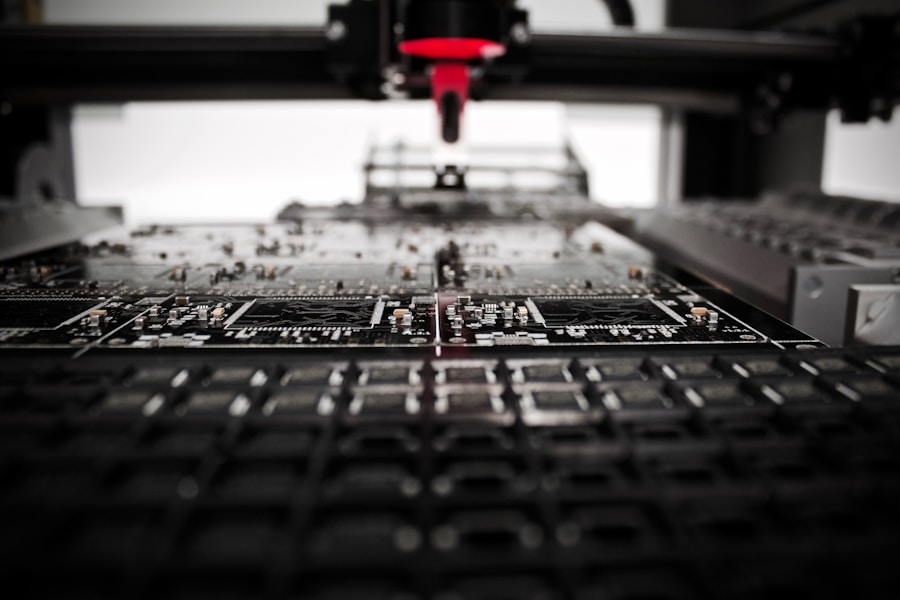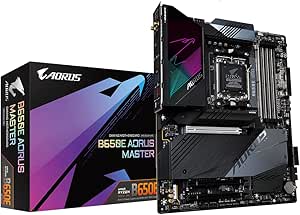The motherboard is the central component of any computer, serving as the main hub that connects all other hardware components. It is often referred to as the “heart” of the computer, as it is responsible for facilitating communication between the CPU, RAM, storage devices, and other essential components. Without a functioning motherboard, a computer would not be able to operate.
Motherboards come in various sizes and form factors, with the most common being ATX, Micro-ATX, and Mini-ITX. The size and form factor of a motherboard determine its compatibility with different computer cases and the number of expansion slots and ports it can accommodate. When selecting a motherboard for a build or upgrade, it is crucial to consider the compatibility with other components such as the CPU, RAM, and graphics card. Additionally, the motherboard’s chipset and socket type must match those of the CPU to ensure proper functionality.
In addition to providing physical connections for hardware components, motherboards also contain essential circuitry and firmware that enable the computer to boot up and operate. The Basic Input/Output System (BIOS) or Unified Extensible Firmware Interface (UEFI) is stored on a chip on the motherboard and is responsible for initializing hardware components during the boot process. Understanding the basics of motherboards is crucial for anyone looking to build or upgrade a computer, as it forms the foundation for the entire system.
Exploring the Components: A Breakdown of the Different Parts of a Motherboard
A typical motherboard consists of several key components that work together to facilitate the operation of a computer. The most prominent component is the CPU socket, which houses the processor and provides the necessary connections for power and data transfer. The CPU socket type must match that of the processor to ensure compatibility and proper functionality. Additionally, modern motherboards often feature multiple RAM slots, allowing for the installation of various memory modules to increase system performance.
Another essential component of a motherboard is the chipset, which acts as a bridge between the CPU, RAM, storage devices, and other hardware components. The chipset plays a crucial role in facilitating communication and data transfer between different parts of the computer. It also determines the motherboard’s compatibility with specific CPUs and features such as overclocking and storage options.
Furthermore, motherboards contain expansion slots and ports that allow for the installation of additional hardware components such as graphics cards, sound cards, and networking cards. These expansion slots come in various formats, including PCI Express (PCIe) and legacy PCI slots, each with its own bandwidth and compatibility specifications. Additionally, modern motherboards feature a variety of ports for connecting peripherals such as USB devices, audio equipment, and networking cables. Understanding the different components of a motherboard is essential for selecting compatible hardware and optimizing system performance.
The Role of the BIOS: How the Basic Input/Output System Controls Your Computer
The Basic Input/Output System (BIOS) or Unified Extensible Firmware Interface (UEFI) is a critical component of any motherboard, responsible for initializing hardware components during the boot process. The BIOS/UEFI is stored on a chip on the motherboard and contains firmware that provides low-level control over essential functions such as power management, hardware configuration, and system booting. When a computer is powered on, the BIOS/UEFI performs a series of checks and configurations to ensure that all hardware components are functioning correctly before handing control over to the operating system.
In addition to facilitating the boot process, the BIOS/UEFI also provides a user interface for configuring various system settings such as boot order, CPU settings, memory timings, and storage options. These settings can have a significant impact on system performance and stability, making it essential to understand how to access and modify them when necessary. Overclocking enthusiasts often rely on the BIOS/UEFI to adjust CPU and memory settings to maximize performance, although this should be done with caution to avoid damaging hardware.
Furthermore, modern motherboards often feature advanced UEFI interfaces with graphical user interfaces (GUIs) and mouse support, making it easier for users to navigate and configure system settings. Some motherboards also support dual BIOS/UEFI setups, allowing for easy recovery in case of firmware corruption or failed updates. Understanding the role of the BIOS/UEFI is crucial for anyone looking to customize their system settings or troubleshoot boot-related issues.
Understanding Expansion Slots: How Motherboards Allow for Upgrades and Customization
Expansion slots are an essential feature of motherboards that allow for the installation of additional hardware components to expand system functionality. The most common type of expansion slot found on modern motherboards is PCI Express (PCIe), which comes in various sizes and configurations to accommodate different types of expansion cards. Graphics cards, sound cards, networking cards, and storage controllers are among the many devices that can be installed in PCIe slots to enhance system performance and connectivity.
In addition to PCIe slots, some motherboards also feature legacy PCI slots that support older expansion cards that may still be in use. However, PCIe has largely replaced PCI due to its higher bandwidth and improved compatibility with modern hardware. When selecting a motherboard for a build or upgrade, it is crucial to consider the number and type of expansion slots it offers to ensure compatibility with desired expansion cards.
Furthermore, some high-end motherboards feature M.2 slots that support ultra-fast NVMe solid-state drives (SSDs) for high-speed storage solutions. M.2 slots provide direct connections to the CPU or chipset, bypassing traditional SATA interfaces for improved performance. Understanding expansion slots is essential for anyone looking to customize their system with additional hardware components or upgrade storage solutions.
The Importance of Chipsets: How They Connect and Communicate with Other Hardware
The chipset is a crucial component of any motherboard that acts as a bridge between the CPU, RAM, storage devices, and other hardware components. It consists of two main parts: the Northbridge and Southbridge (or Platform Controller Hub on modern Intel platforms), each responsible for different functions related to system communication and data transfer. The Northbridge handles high-speed connections between the CPU, RAM, and PCIe slots, while the Southbridge manages lower-speed connections such as USB, SATA, and networking interfaces.
The chipset plays a crucial role in determining a motherboard’s compatibility with specific CPUs and features such as overclocking support, memory speeds, and storage options. Different chipsets offer varying levels of performance and connectivity options, making it essential to select a motherboard with a chipset that meets your specific needs. For example, high-end chipsets such as Intel’s Z-series offer extensive overclocking support and multiple PCIe lanes for high-speed storage and networking solutions.
Furthermore, modern chipsets often integrate various features such as USB 3.1 Gen 2 support, Wi-Fi connectivity, and advanced audio solutions to enhance system functionality. Some chipsets also support technologies such as Intel Optane Memory or AMD StoreMI for improved storage performance through intelligent caching solutions. Understanding the importance of chipsets is crucial for anyone looking to build or upgrade a computer, as it directly impacts system performance and connectivity options.
Overclocking and Performance: Maximizing the Potential of Your Motherboard
Overclocking is a popular method used by enthusiasts to maximize the performance of their computer hardware beyond factory specifications. It involves adjusting CPU and memory settings in the BIOS/UEFI to increase clock speeds and improve system responsiveness. Overclocking can lead to significant performance gains in tasks such as gaming, video editing, and 3D rendering by pushing hardware components to their limits.
Modern motherboards often feature extensive overclocking support through advanced BIOS/UEFI interfaces that allow users to adjust voltage levels, clock speeds, and memory timings with precision. High-end motherboards with robust power delivery systems are particularly well-suited for overclocking, as they can provide stable power delivery to demanding CPUs under heavy loads. Additionally, some motherboards feature dedicated overclocking profiles and automatic tuning utilities that simplify the process for beginners.
However, overclocking should be approached with caution, as it can lead to increased heat generation and power consumption that may affect system stability and longevity. Proper cooling solutions such as aftermarket CPU coolers and case fans are essential for maintaining safe operating temperatures during overclocking. It is also important to monitor hardware temperatures and stability using software utilities such as CPU-Z or Prime95 to ensure that overclocked settings are stable under load.
Understanding overclocking and its impact on system performance is crucial for anyone looking to push their hardware to its limits while maintaining stability and reliability. With proper knowledge and precautions, overclocking can be an effective way to extract additional performance from your motherboard and CPU.
Troubleshooting and Maintenance: Common Issues and How to Keep Your Motherboard Running Smoothly
Like any other electronic device, motherboards are susceptible to various issues that may affect their functionality over time. Common problems include boot failures, intermittent connectivity issues, overheating, and hardware conflicts that can disrupt system operation. Troubleshooting these issues often requires a systematic approach to identify potential causes and implement appropriate solutions.
One common troubleshooting step is to check for loose connections or damaged components such as RAM modules or expansion cards that may be causing system instability. Re-seating these components or testing them in different slots can help identify potential issues related to poor contact or faulty hardware. Additionally, checking for firmware updates for the BIOS/UEFI or other hardware components can address compatibility issues or security vulnerabilities that may affect system stability.
Regular maintenance practices such as cleaning dust buildup from fan vents and heatsinks can help prevent overheating issues that may lead to system instability or hardware damage. Proper cable management inside the computer case can also improve airflow and reduce heat buildup around critical components such as the CPU and GPU. Furthermore, using quality power supplies with stable voltage regulation can prevent electrical issues that may damage sensitive electronics on the motherboard.
Understanding common issues related to motherboard operation and implementing proper maintenance practices is essential for keeping your computer running smoothly over time. By staying proactive in identifying potential problems and implementing appropriate solutions, you can ensure that your motherboard continues to provide reliable performance for years to come.
In conclusion, understanding the basics of motherboards is crucial for anyone looking to build or upgrade a computer system. From selecting compatible hardware components to optimizing system performance through overclocking, motherboards play a central role in facilitating communication between different parts of a computer. By familiarizing yourself with the various components, features, and maintenance practices related to motherboards, you can ensure that your computer operates smoothly while maximizing its potential for performance and customization.




